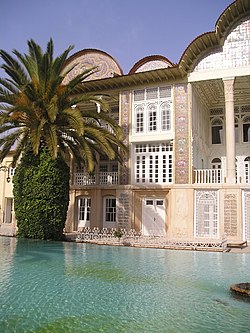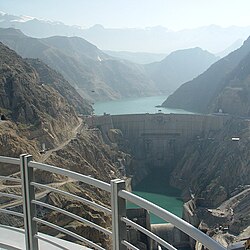The main external partner of the Iranian water and sanitation sector during the first decade of the 21st century was the World Bank. Today the main external partners are the Islamic Development Bank, the United Nations and NGOs.
Islamic Development Bank
The Islamic Development Bank (IDB) has allocated more than 800 million euros of loans in total for Iran's water and wastewater projects as of 2014, including 65 million euros for eastern Mashhad's wastewater project, 140 million euros for projects in the cities of Qom and Kashan in central Iran, 175 million euros to Tehran, 195 million euros to rural wastewater projects and 92 million euros to Qom province's water project, 80 million euros for wastewater projects in Hamedan and Qeshm, and 144 million euro for wastewater projects in the southern Fars province. [34] The Iranian wastewater sector is the largest recipient of IDB water and wastewater funds in the world, as the IDB has funded some of the gap caused by international sanctions. [35] With 8.28% of the shares Iran is the third-largest shareholder of the IDB, whose largest shareholder is Saudi Arabia. [36]
United Nations
UNESCO-IHE in Delft, The Netherlands, together with the Power and Water University of Technology (Shahid Abbaspour) in Iran, will train 2,100 Iranian professionals in water and wastewater technologies, planning and management. The training will consist of 59 courses to take place in 2008 and the first half of 2009. In addition, 20 study tours to European water and wastewater companies for senior managerial, financial and technical staff will be organized. [29]
Foreign Non-governmental Organizations
Unlike other lower and middle-income countries, Iran hosts few private international non-governmental organizations that pursue environmental or social aims. Despite the difficult operating environment and friction with ruling bodies, the Iranian Government has moved to encourage an increased participation by foreign NGOs. [37] As a result, some organizations that closed operations have resumed their activities, and new startup organizations, including those that work in the areas of water and sanitation, have initiated projects in Iran. One such organization, Healing For Iran, recently launched a program to improve rural access to water and investigate the causes of water contamination in disadvantaged populations. [38]
World Bank
The World Bank was engaged in water and sanitation in the Islamic Republic of Iran between 2000 and 2010. Its engagement began with the approval of the Tehran Sewerage Project in 2000, followed by the approval of two other projects in 2004 and 2005. In 2010 its last project, The Northern Cities Water Supply and Sanitation Project, closed. The project, supported by a US$224m loan, aimed to enhance the quality of life in the four northern cities of Rasht and Anzali in Gilan province, as well as Sari and Babol in Mazandaran province. It aimed to do so by improving the operational efficiency and financial sustainability of the two Provincial Water and Wastewater Companies (WWCs). The project financed the extension and improvement of water distribution systems including metering, sanitary sewers, and a wastewater treatment plant (in Sari) which was not completed at project closure. [18] The project did not succeed in improving the financial situation of the two water and wastewater companies, since tariff increases were delayed. [39]
The Ahvaz and Shiraz Water Supply and Sanitation Project, supported by a US$279m loan approved in 2004 and closed in 2009, aimed to improve access to satisfactory water supply and significantly increasing coverage of sanitation services; and improve environmental, hygiene and health conditions, as well as promoting reuse of treated effluents. It also aimed to strengthen and develop the capacity of Ahvaz and Shiraz Water and Wastewater Companies, and assist the latter in improving their efficiency, sustainability and financial autonomy. It also aimed to initiate sector reforms, particularly with respect to institutional arrangements, the regulatory framework, demand management, as well as prepare a sanitation strategy. [40]
The Tehran Sewerage Project, supported by a US$145m loan, closed in 2008. Its objective was to improve the environmental conditions in the Greater Tehran area through the installation of wastewater collection and treatment facilities, to improve public health, and enable unrestricted irrigation practices in the surrounding areas. Chlorination would disinfect effluents treated at the secondary level for suitable irrigation purposes, and a further tertiary treatment was to be extended if required. Treated effluents, and sludge were to be reused for agricultural purposes. [41] The project allowed to connect more than 1.3 million people to the sewer system and to build a wastewater treatment plant that was completed in June 2009. A World Bank completion report concluded that the project reached its objectives and performed satisfactorily. [42]
The World Bank says that international financial institutions are exempt from the sanctions imposed by the UN on Iran. [43] In September 2013, the World Bank removed Iran from its list of borrowers that cannot receive new loans, saying the Islamic Republic had paid outstanding loan amounts. In April 2014, Iranian Finance and Economic Affairs Minister Ali Tayyebnia asked the World Bank to provide Iran with financial assistance to implement development projects. [44]


